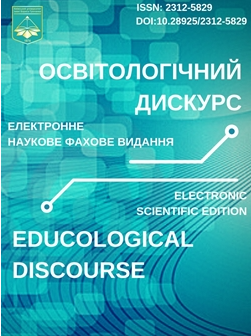The Use of Augmented Reality and Virtual Reality Technologies in Teaching Foreign Languages
DOI:
https://doi.org/10.28925/2312-5829.2023.110Keywords:
AR technologies, digital skills, foreign languages teaching, modern technologies of teaching, VR technologiesAbstract
The article is devoted to analyzing the educational potential of augmented reality (AR) and virtual reality (VR) technologies in teaching foreign languages, specifically in the professional training of future teachers. The possibility and benefits of introducing AR technologies in the system of teachers’ professional training are based on the experience of the discipline «Modern Technologies of Teaching a Foreign Language to Preschool Children», which is taught during the first (bachelor's) level of education to students of the 012 Preschool Education Specialty at the Faculty of Pedagogical Education in Borys Grinchenko Kyiv University. The literature analysis and the description of the empirical experience of the interaction and implementation of AR and VR technologies in the course content are the major research methods used in this article. The article performs an analysis of the advantages and disadvantages of AR and VR technologies in foreign language teaching. The didactic potential of both aforementioned technologies is identified, including the improved learning environment, increased motivation, interaction, and content retention, the richness of multimedia modes, better visualization, and suitability for special learning needs. The article emphasizes the influence on multiple language skills and vocabulary development (vocabulary acquisition, phonics, pronunciation, comprehension, writing, reading, speaking, improved communication, and general learning skills). The data received proves the suitability and benefits of implementing current AR technologies in the professional training of future teachers and language teaching in general, as opposed to VR technologies that are limited due to their drawbacks that outweigh their current advantages, but still allow them to be considered a very powerful tool in the near future. Still, their partial accessibility by learners gives them the right to be used in terms of the realization of individual approaches. As a result of this article, a list of AR and VR technologies that could be used in foreign language teaching is revealed. The perspective of future research could focus on the analysis of specific technologies from AR or VR groups
Downloads
References
Alakärppä, I. H., Jaakkola, E. S., Väyrynen, J. M. O., & Häkkilä, J. R. (2017). Using nature elements in mobile AR for education with children. In M. Jones, M. Tscheligi, Y. Rogers, & R. Murray-Smith (Eds.), Proceedings of the 19th International Conference on Human-Computer Interaction with Mobile Devices and Services [41] ACM. https://dl.acm.org/citation.cfm?id=3098547&CFID=814782530&CFTOKEN=15128730
Al Farsi, G., Yusof, A. bin M., Romli, A., Tawafak, R. M., Malik, S. I., Jabbar, J., & Rsuli, M. E. B. (2021). A Review of Virtual Reality Applications in an Educational Domain. International Journal of Interactive Mobile Technologies (iJIM), 15(22), pp. 99–110. https://doi.org/10.3991/ijim.v15i22.25003
Elmqaddem, N. (2019). Augmented Reality and Virtual Reality in Education. Myth or Reality?. International Journal of Emerging Technologies in Learning (iJET), 14(03), pp. 234–242. https://doi.org/10.3991/ijet.v14i03.9289
Garzón, J. (2021). An Overview of Twenty-Five Years of Augmented Reality in Education. Multimodal Technologies and Interaction, 5, 37. https://doi.org/10.3390/mti5070037
Gödde, M., Gabler, F., Siegmund, D., & Braun, A. (2018). Cinematic Narration in VR – Rethinking Film Conventions for 360 Degrees. In Chen, J., Fragomeni, G. (eds), Proceedings of the 10th International Conference on Virtual, Augmented and Mixed Reality: Applications in Health, Cultural Heritage, and Industry. Lecture Notes in Computer Science, 10910. Springer, Cham. https://doi.org/10.1007/978-3-319-91584-5_15
Karacan, C. G., & Kemal A. Educational Augmented Reality Technology for Language Learning and Teaching: A Comprehensive Review. Shanlax International Journal of Education, 9(2), 2021, 68-79. https://doi.org/10.34293/education.v9i2.3715
Kosharna, N., & Petryk, L. (2022). Hyflex Organization of Foreign Language Teaching: Specialties 013 «Primary Education» and 012 «Preschool Education». Continuing Professional Education: Theory and Practice, (3), 24–32. https://doi.org/10.28925/1609-8595.2022.3.3
Khoruzha, L., Proshkin, V., Kotenko, O., & Smyrnova-Trybulska, E. (2019). Digital competence: abilities of a lecturer and expectations of students (Ukrainian-Polish context). E-learning and STEM Education, 11, 421-439. https://doi.org/10.34916/el.2019.11.27
Lan, Y.J. (2020). Immersion, interaction, and experience-oriented learning: Bringing virtual reality into FL learning, Language Learning and Technology, 24(1), 1-15.
Nezhyva, L., & Palamar, S. (2021). Preparation of future primary school teachers for the use of augmented reality in literacy and literary reading lessons. Educological discourse, 2(33), 144-159. https://doi.org/10.28925/2312-5829.2021.2.11
Smutny, P., Babiuch, M., & Foltynek, P. (2019). A Review of the Virtual Reality Applications in Education and Training, 20th International Carpathian Control Conference (ICCC), Krakow-Wieliczka, Poland, 1-4, doi: 10.1109/CarpathianCC.2019.8765930
Tan, Y., Xu, W., Li, S., & Chen, K. (2022). Augmented and Virtual Reality (AR/VR) for Education and Training in the AEC Industry: A Systematic Review of Research and Applications. Buildings 12, 1529. https:// doi.org/10.3390/buildings12101529
Udovychenko, L., Kuzminets, N., Stadnik, O., Kosharna, N., Petryk, L. (2021). The use of blended learning technology in the training for students of pedagogical specialties. Revista on line de Política e Gestão Educacional, 25(3), 2258-2271. https://doi.org/10.22633/rpge.v25i3.15958
Published
How to Cite
Issue
Section
License
Copyright (c) 2023 Educological discourse

This work is licensed under a Creative Commons Attribution-NonCommercial 4.0 International License.
Автори зберігають за собою всі авторські права та одночасно надають журналу право першої публікації на умовах лізенції Creative Commons Attribution-NonCommercial-ShareAlike 3.0 Unported License, що дозволяє розповсюджувати даний матеріал із зазначенням авторства та первинної публікації в даному журналі.





















